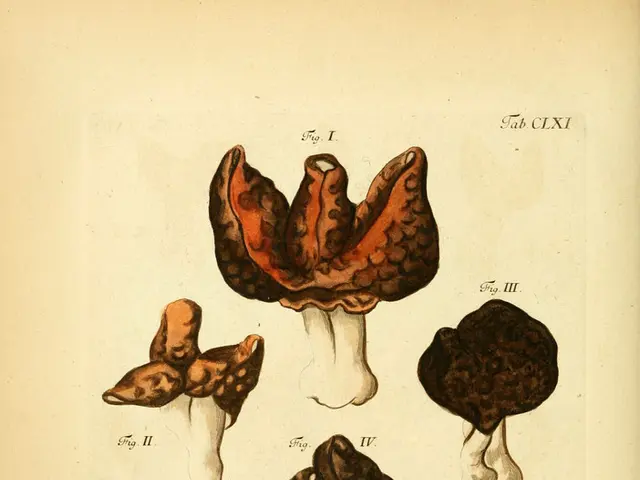Angular Cheilitis: Information on Causes, Remedies, and Transmission
**News Article: Understanding and Managing Angular Cheilitis**
Angular Cheilitis (AC), a common condition affecting the corners of the mouth, is characterised by painful red cracks, soreness, and sometimes bleeding. This inflammatory condition is primarily caused by excessive moisture and skin breakdown due to saliva accumulation, which often leads to secondary infections by organisms like *Candida albicans* (yeast) or *Staphylococcus aureus* (bacteria).
### Common Causes of Angular Cheilitis
The condition can be triggered by various factors, including the pooling of excess saliva at the corners of the mouth, which can be caused by wearing dentures (especially ill-fitting ones), braces or malocclusion (misaligned teeth), excessive lip licking or thumb sucking, drooling, or dry mouth conditions. Secondary infections, such as candidiasis (yeast) or bacterial infections, may also occur.
Irritants and allergens, such as exposure to chemicals in foods, oral hygiene products, or skin care items, can also contribute to AC. Medical conditions like HIV/AIDS, diabetes, Sjogren’s syndrome, lupus, and inflammatory bowel diseases can increase susceptibility, as can lifestyle factors such as smoking, frequent gum chewing, mask-wearing, and poor oral hygiene.
### Treatments for Angular Cheilitis
Treatment for AC focuses on eliminating infection, protecting the skin, and correcting predisposing factors. This may involve addressing ill-fitting dentures, improving oral hygiene, and treating malocclusion to prevent saliva build-up. Topical antifungal or antibiotic medications may be used to control secondary infection by yeast or bacteria, while barrier ointments and emollients can protect the skin from moisture and promote healing. Nutritional supplementation may be necessary for those with identified deficiencies.
### Prevention Methods
Prevention methods for AC include maintaining good oral hygiene, ensuring proper fit of dental devices like dentures or braces, avoiding lip licking and thumb sucking habits, protecting lips from excessive moisture and saliva pooling, keeping lips moisturized with lip balms or protective ointments, addressing and managing underlying medical conditions and nutritional deficiencies, and using sun protection on lips when outdoors.
In summary, Angular Cheilitis arises mainly from moisture-induced skin breakdown and infection, with treatment focusing on eliminating infection, protecting the skin, and correcting predisposing factors. Prevention requires maintaining lip health, avoiding irritants, and managing habits or conditions that cause saliva pooling.
It is essential to note that AC is not contagious and will not spread to other people. However, if the inflammation associated with AC is infected, it can spread elsewhere on a person's body. Untreated AC can lead to yeast or other infections, and people should consult a doctor if home remedies do not help or symptoms worsen.
AC is not the same as a cold sore, as cold sores occur anywhere along the lip or lip line, not usually in both corners of a person's mouth. AC can extend slightly onto the lips or skin but primarily affects the corners of the mouth. The technical term for the affected areas is the labial or oral commissures.
References:
[1] Mayo Clinic. (2021). Angular cheilitis. Retrieved from https://www.mayoclinic.org/diseases-conditions/angular-cheilitis/symptoms-causes/syc-20350154
[2] Cleveland Clinic. (2021). Angular cheilitis. Retrieved from https://my.clevelandclinic.org/health/diseases/17300-angular-cheilitis
[3] American Academy of Dermatology. (2021). Angular cheilitis. Retrieved from https://www.aad.org/public/diseases/a-z/angular-cheilitis
[4] American Academy of Dermatology. (2021). Actinic cheilitis. Retrieved from https://www.aad.org/public/diseases/a-z/actinic-cheilitis
- The pooling of excess saliva at the corners of the mouth due to wearing ill-fitted dentures can escalate into Angular Cheilitis (AC).
- Dermatitis, commonly seen in Angular Cheilitis, can be a result of a predictive degeneration of the macular tissue in the corners of the mouth.
- Oral herpes, a viral infection causing mouth ulcers, should not be confused with Angular Cheilitis, as the latter primarily affects the corners of the mouth.
- Atopic conditions, such as eczema, may predispose individuals to Angular Cheilitis, suggesting a potential link between the two conditions.
- The skin commissures, specifically at the corners of the mouth, are more vulnerable to nondigestive ulcers and dryness, factors that can contribute to Angular Cheilitis.
- In the realm of science, studying the causes and treatments for Angular Cheilitis is crucial for enhancing health-and-wellness, particularly in the field of skin-care.
- Adopting a fitness-and-exercise routine can boost overall health, which may help prevent Angular Cheilitis by supporting a strong immune system.
- Mental-health plays a significant role in maintaining a balanced immune system, potentially reducing the risk of Angular Cheilitis and other inflammatory conditions.
- HIV, a viral infection, is among the medical conditions that can increase susceptibility to Angular Cheilitis, highlighting the importance of regular health screenings.
- In addition to Probiotics, a healthy diet rich in essential nutrients can help alleviate symptoms of Angular Cheilitis, promoting healing and preventing recurrences.




